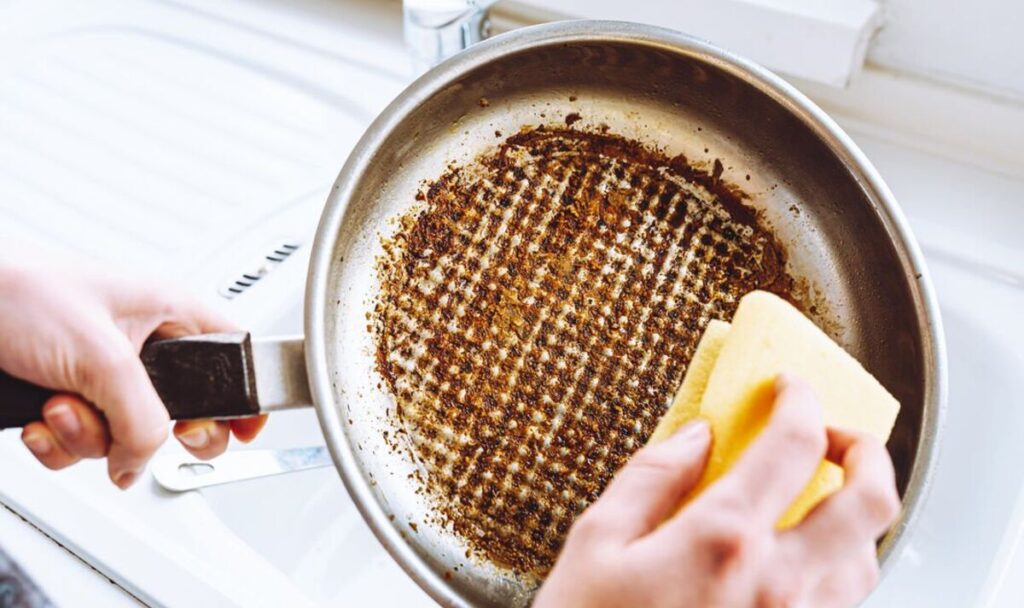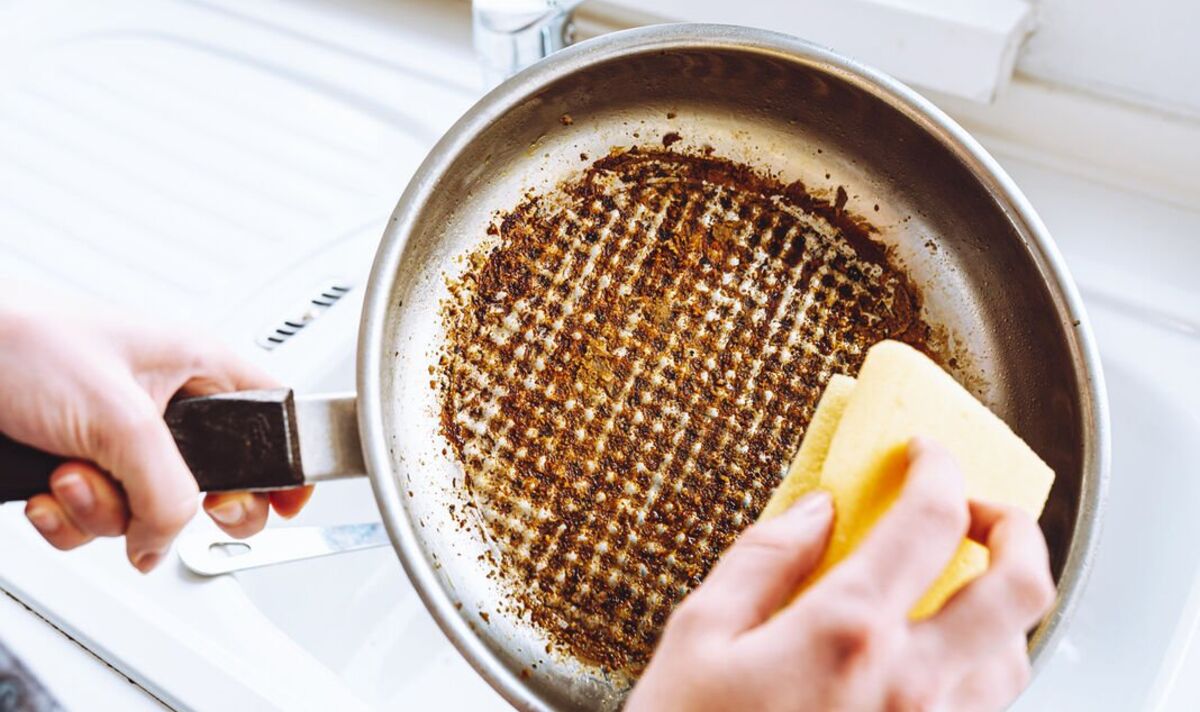
The Ultimate Guide: How to Get Burn Marks Off Your Pans (and Keep Them Sparkling)
Discovering stubborn burn marks on your favorite pan can be incredibly frustrating. Whether it’s a stainless steel skillet, a non-stick frying pan, or a cast iron workhorse, those unsightly marks seem impossible to remove. But don’t despair! This comprehensive guide will equip you with proven methods to restore your pans to their former glory, preventing future mishaps, and ensuring they remain a valuable part of your kitchen for years to come.
We’ll delve into the science behind burnt-on food, explore a variety of cleaning techniques – from gentle simmering to more intensive scrubbing – and provide expert tips on maintaining your cookware to prevent future burns. This isn’t just about cleaning; it’s about understanding your pans and ensuring their longevity. Let’s get started!
Understanding the Science of Burn Marks on Pans
Before we dive into cleaning methods, it’s helpful to understand what causes those stubborn burn marks. The primary culprit is the Maillard reaction, a chemical reaction between amino acids and reducing sugars that occurs when food is heated. This reaction is responsible for the delicious browning and flavor development in cooked food, but when it goes too far, it results in burnt-on residue. Another factor is simple carbonization – the charring of food due to excessive heat.
The type of pan also plays a significant role. Stainless steel, while durable, can easily develop burn marks if food isn’t properly monitored. Non-stick pans, with their delicate coatings, are susceptible to damage from high heat and abrasive cleaning tools. Cast iron, known for its heat retention, can accumulate layers of baked-on residue over time if not cleaned properly. Understanding these factors will guide you in choosing the most effective cleaning approach.
Essential Tools and Cleaning Supplies
Having the right tools and supplies is crucial for effectively removing burn marks without damaging your pans. Here’s a list of essentials:
- Baking Soda: A mild abrasive and deodorizer.
- White Vinegar: An excellent degreaser and acid cleaner.
- Dish Soap: For general cleaning and degreasing.
- Salt: A natural abrasive.
- Water: For dissolving cleaning agents and rinsing.
- Non-Abrasive Sponges or Scrub Brushes: To avoid scratching surfaces.
- Plastic or Nylon Scrapers: For loosening stubborn residue.
- Paper Towels or Soft Cloths: For wiping and drying.
- Rubber Gloves: To protect your hands.
Optional but helpful tools:
- Bar Keeper’s Friend: A powdered cleaner with oxalic acid, effective for stainless steel.
- Oven Cleaner: For heavily burnt stainless steel or cast iron (use with caution).
- Boiling Water: To loosen burnt food particles.
- Dryer Sheets: Surprisingly effective for soaking and loosening residue.
Gentle Cleaning Methods: Simmering and Soaking
For lightly burnt pans, start with gentle cleaning methods before resorting to more abrasive techniques. Simmering and soaking can often loosen the residue enough for easy removal.
Simmering with Vinegar and Baking Soda
- Fill the Pan: Add about 1 cup of water and ½ cup of white vinegar to the burnt pan.
- Bring to a Simmer: Place the pan on the stove and bring the mixture to a gentle simmer for 5-10 minutes.
- Add Baking Soda: Remove the pan from the heat and add 2 tablespoons of baking soda. The mixture will fizz.
- Scrub Gently: Once the fizzing subsides, use a non-abrasive sponge or scrub brush to gently scrub the burnt areas.
- Rinse and Repeat: Rinse the pan thoroughly with water. If any residue remains, repeat the process.
Soaking with Dish Soap and Hot Water
- Fill the Pan: Fill the burnt pan with hot water and add a generous squirt of dish soap.
- Soak: Let the pan soak for at least 30 minutes, or even overnight for heavily burnt pans.
- Scrub Gently: After soaking, use a non-abrasive sponge or scrub brush to gently scrub the burnt areas.
- Rinse and Repeat: Rinse the pan thoroughly with water. If any residue remains, repeat the soaking process.
Tackling Tough Burn Marks: Abrasive Cleaning Techniques
When gentle methods fail, it’s time to bring out the big guns. Abrasive cleaning techniques can effectively remove stubborn burn marks, but it’s crucial to use them carefully to avoid damaging your pans.
Baking Soda Paste
- Make a Paste: Mix baking soda with a small amount of water to form a thick paste.
- Apply the Paste: Apply the paste to the burnt areas of the pan.
- Scrub Vigorously: Use a non-abrasive sponge or scrub brush to scrub the paste into the burnt residue.
- Rinse Thoroughly: Rinse the pan thoroughly with water, ensuring all traces of the baking soda paste are removed.
Salt Scrub
- Sprinkle Salt: Sprinkle a generous amount of salt onto the burnt areas of the pan.
- Add a Little Water: Add just enough water to moisten the salt.
- Scrub: Use a non-abrasive sponge or scrub brush to scrub the salt into the burnt residue.
- Rinse Thoroughly: Rinse the pan thoroughly with water.
Bar Keeper’s Friend (for Stainless Steel)
- Wet the Pan: Wet the stainless steel pan with water.
- Sprinkle Bar Keeper’s Friend: Sprinkle a small amount of Bar Keeper’s Friend onto the burnt areas.
- Scrub Gently: Use a non-abrasive sponge or scrub brush to gently scrub the Bar Keeper’s Friend into the burnt residue.
- Rinse Thoroughly: Rinse the pan thoroughly with water.
Important Note: Always test abrasive cleaning methods in an inconspicuous area first to ensure they don’t damage the pan’s surface.
Cleaning Different Types of Pans
The best method for how to get burn marks off pan depends on the type of pan you’re dealing with. Here’s a breakdown of specific approaches for common cookware materials:
Stainless Steel Pans
Stainless steel is durable but prone to burn marks. For stubborn residue, try the Bar Keeper’s Friend method described above. You can also use a paste of baking soda and hydrogen peroxide for extra cleaning power. For extremely burnt stainless steel, you can carefully use oven cleaner, following the manufacturer’s instructions and ensuring proper ventilation.
Non-Stick Pans
Non-stick pans require gentle care to avoid damaging the coating. Avoid abrasive cleaners and scrub brushes. Stick to soaking with dish soap and hot water, followed by gentle scrubbing with a soft sponge. For tougher stains, try simmering with vinegar and water, but avoid prolonged simmering as it can degrade the non-stick coating.
Cast Iron Pans
Cast iron can handle more aggressive cleaning, but it’s essential to maintain the seasoning. After cleaning, dry the pan thoroughly and re-season it with a thin layer of oil. For heavily burnt cast iron, you can use oven cleaner or even burn off the residue in a self-cleaning oven (though this can be harsh on the seasoning).
Enameled Cast Iron Pans
Enameled cast iron combines the heat retention of cast iron with a non-reactive enamel coating. Avoid abrasive cleaners and metal utensils that can scratch the enamel. Soaking with dish soap and hot water is usually sufficient. For stubborn stains, try a baking soda paste or a specialized enamel cleaner.
Preventing Burn Marks: Tips for Pan Care
Prevention is always better than cure. Here are some tips to prevent burn marks and keep your pans in top condition:
- Use the Right Heat: Avoid using excessively high heat, especially with non-stick pans.
- Stir Frequently: Stir food regularly to prevent it from sticking and burning.
- Add Liquid: If food starts to stick, add a little liquid (water, broth, or wine) to deglaze the pan and prevent burning.
- Don’t Overcrowd the Pan: Overcrowding the pan can lower the temperature and lead to uneven cooking and sticking.
- Clean Immediately: Clean your pans as soon as possible after use to prevent residue from hardening.
- Proper Storage: Store your pans properly to avoid scratches and damage. Use pan protectors or hang them on a rack.
- Season Cast Iron Regularly: Maintain the seasoning of your cast iron pans to prevent rust and sticking.
The Science Behind Effective Cleaning Agents: A Deeper Dive
Let’s explore why the recommended cleaning agents are effective in removing burn marks. Baking soda, or sodium bicarbonate, is a mild alkali that helps to dissolve grease and loosen burnt-on food. Its slightly abrasive nature provides gentle scrubbing power without scratching most surfaces. White vinegar, containing acetic acid, is a natural degreaser and disinfectant. The acidity helps to break down food particles and mineral deposits. Dish soap contains surfactants that reduce surface tension, allowing water to penetrate and lift away dirt and grease. Bar Keeper’s Friend contains oxalic acid, which is particularly effective at removing rust stains and mineral deposits from stainless steel. Understanding these chemical properties can help you choose the right cleaning agent for the specific type of burn mark you’re dealing with.
Expert Tips for Maintaining Your Cookware Investment
Investing in high-quality cookware is a significant expense, so it’s crucial to maintain your pans properly to extend their lifespan. Avoid using metal utensils on non-stick surfaces, as they can scratch the coating. Always hand-wash non-stick pans to prevent damage from the dishwasher’s harsh detergents and high heat. For stainless steel pans, avoid using steel wool or other highly abrasive scrubbers, as they can leave scratches. Regularly season your cast iron pans to maintain their non-stick properties and prevent rust. By following these expert tips, you can ensure that your cookware remains in excellent condition for years to come.
Burned Food Odor Removal: Beyond the Pan
Sometimes, even after successfully removing burn marks from your pan, the lingering odor of burnt food can persist in your kitchen. To eliminate this unpleasant smell, try simmering a pot of water with lemon slices, vinegar, or cinnamon sticks. The steam will help to absorb the odor and freshen the air. You can also place bowls of baking soda or activated charcoal around the kitchen to absorb odors. Ensure proper ventilation by opening windows and using exhaust fans. By addressing both the pan and the surrounding environment, you can completely eliminate the evidence of your cooking mishap.
Choosing the Right Cookware: A Proactive Approach
Selecting the right type of cookware can significantly reduce the likelihood of burn marks in the first place. Consider your cooking style and the types of food you typically prepare. Stainless steel is a versatile option for searing and browning, while non-stick is ideal for delicate foods like eggs and fish. Cast iron is excellent for high-heat cooking and heat retention. Enameled cast iron combines the benefits of both cast iron and enamel. Research different brands and read reviews to find cookware that is durable, easy to clean, and resistant to burn marks. Investing in high-quality cookware is a proactive step towards preventing future cleaning headaches.
Keeping Your Pans Sparkling: A Few Parting Thoughts
Removing burn marks from pans can seem like a daunting task, but with the right techniques and a little patience, you can restore your cookware to its original shine. Remember to start with gentle methods and gradually increase the intensity as needed. Always consider the type of pan you’re cleaning and choose appropriate cleaning agents and tools. By following the tips and techniques outlined in this guide, you can keep your pans sparkling and extend their lifespan, ensuring they remain a valuable part of your kitchen for years to come. Embrace these cleaning strategies, and you’ll be ready to tackle any culinary challenge!

